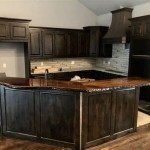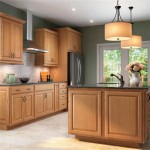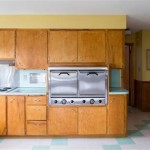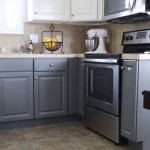Tips for Painting Around Kitchen Cabinets with Precision
Transforming your kitchen with a fresh coat of paint can dramatically enhance its aesthetic appeal. However, painting around kitchen cabinets can pose a unique challenge due to their complex shape and intricate details. With careful preparation, attention to detail, and the right techniques, you can achieve a flawless paint job that seamlessly blends with the cabinets.
1. Prepare the Area Thoroughly
Before you start painting, it's crucial to prepare the area around the cabinets. Remove all hardware, such as knobs and handles, and cover them with painter's tape. Clean the cabinets thoroughly with a degreasing agent to remove any dirt or grease that could interfere with the paint's adhesion.
2. Trim the Edges First
Instead of attempting to paint the entire surface of the cabinets at once, focus on the edges first. Use a small paintbrush or an angled sash brush to carefully trim the edges along the wall, the countertop, and any other adjacent surfaces. This technique ensures that you maintain clean and sharp lines.
3. Use a Brush for Detail Work
For areas that are difficult to reach with a roller, such as the grooves and crevices around the cabinets, switch to a small, high-quality brush. Use a steady hand and apply the paint carefully in thin, even strokes, taking your time to fill in all the gaps.
4. Protect the Cabinets
As you paint, be mindful of protecting the cabinets from paint drips and spatters. Use painter's tape or masking film to cover any exposed surfaces of the cabinets that you don't want to paint. This helps prevent unnecessary touch-ups or damage to the cabinets.
5. Roll the Flat Surfaces
Once the edges and detailing are complete, it's time to tackle the flat surfaces of the cabinets. Use a small roller to apply the paint evenly, avoiding any drips or runs. Roll the paint in smooth, parallel strokes, overlapping each pass to ensure even coverage.
6. Cut In with a Brush
After rolling the flat areas, use a small brush to cut in around the edges of the cabinets. This helps eliminate any gaps or inconsistencies between the roller and the trim work. Hold the brush perpendicular to the surface and apply the paint carefully, feathering the edges.
7. Apply Multiple Coats
To achieve a smooth and durable finish, it's recommended to apply multiple coats of paint. Allow each coat to dry completely before applying the next. This helps prevent the paint from peeling or chipping in the future.
8. Remove Tape Carefully
Once the final coat of paint has dried, carefully remove the painter's tape or masking film. Do this while the paint is still slightly tacky to prevent peeling or damaging the fresh finish. Use a utility knife to remove any stubborn tape residue.
By following these tips, you can confidently tackle the task of painting around kitchen cabinets and achieve a professional-looking result. Remember to take your time, use the right tools, and be patient. With attention to detail and a bit of practice, you can transform your kitchen cabinets and give your kitchen a new lease on life.

How To Paint Kitchen Cabinets Like The Pros

How To Paint Kitchen Cabinets A Step By Guide Confessions Of Serial Do It Yourselfer

How To Paint Kitchen Cabinets

Painting Kitchen Cabinets Best Tips For A Factory Smooth Finish In My Own Style

10 Must Know Cabinet Painting Tips Before You Pick Up A Paint Brush Painted By Kayla Payne

The Right Way To Paint Your Kitchen Cabinets And Save Factory Finish Guaranteed Emily Henderson

20 Diy Painted Kichen Cabinet Ideas A Cultivated Nest

15 Best Painted Kitchen Cabinets Ideas For Transforming Your With Color

10 Tips For Painting Kitchen Cabinets Surepro

The Average Diy Girl S Guide To Painting Cabinets
Related Posts








